\C M16-20 minutes
By the beginning of World War II, there were several types of anti-aircraft machine guns in the Japanese armed forces, which differed constructively and used ammunition.
In navy for Defense The Type 7,7 and Type 92 97 mm machine guns were used on boats and small-displacement vessels. The first was a licensed version of the hand-held Lewis, and the second was also a licensed Vickers-E. The Type 92 naval machine gun was also used by marine landing parties; it was mounted on a universal tripod mount, similar to the American M1917A1, and could fire at ground and air targets.
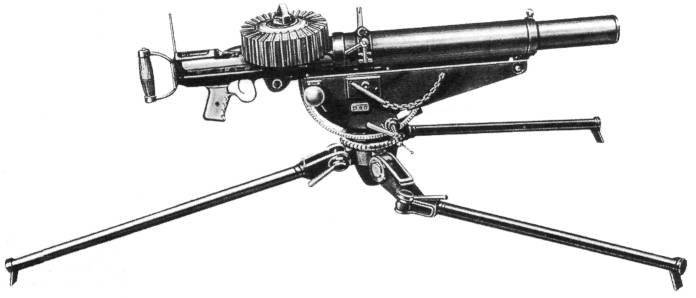
Marine Machine Gun Type 92
The Japanese 7,7 mm cartridge was based on the English cartridge .303 (7,7x57R) used in the Japanese aviation. The main reason for the transition to this ammunition can be considered the need to expand the range of special bullets, then difficult to do in small calibers (6,5 mm), and increase the power of machine gun fire. As a result, three 7,7 mm cartridges of approximately the same power were sequentially adopted: Type 89 with a protruding sleeve edge (British cartridge .303 influence), Type 92 with a low edge and a heavy pointed bullet, Type 99 without a rim and with a lighter bullet . The difficulties of the simultaneous use of different cartridges were somewhat smoothed out by the fact that the Type 89 cartridge was used mainly in the Japanese Air Force and Navy, and the army used cartridges without a rim or with a low rim. In parallel, remained in service weapon caliber 6,5 mm, which significantly complicates the supply of ammunition to the troops.
In the army for firing at low-flying aircraft used heavy machine gun Type 92 caliber 7,7-mm. Its designation corresponded to the calendar “from the founding of the Empire” (1932 the year according to the Gregorian calendar corresponded to the Japanese 2592). By design, the machine gun basically repeated the 6,5-mm heavy machine gun Type 3. He, in turn, was developed by the designer Kiggiro Nambu on the basis of the Hotchiss machine guns purchased in France before the Russian-Japanese war.
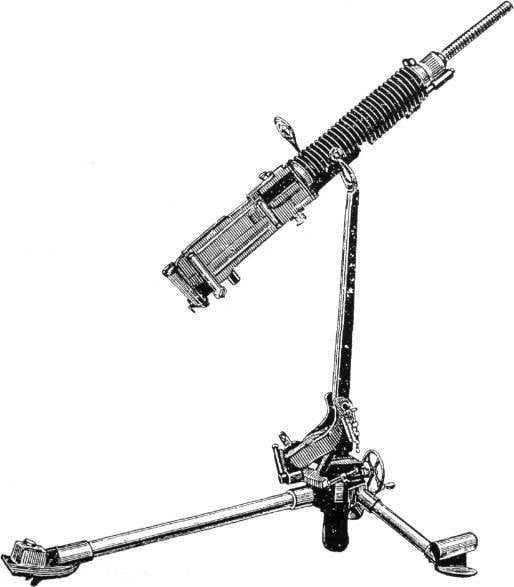
Machine gun Type 92 on a tripod machine in the position for anti-aircraft shooting
The machine gun is powered from rigid tape cassettes (similar to the French Hotchkiss machinegun) with a capacity of 30 ammunition, or from semi-rigid bands consisting of connected hingedly rigid links with a capacity of 3 cartridge each (total 83 link, total capacity of 249 ammunition).

Rigid tape cassette with 30 cartridges of caliber 7,7-mm for a machine gun Type 92
Feed feed – from left to right. The design of the machine gun was provided with a special oiler, which provides lubrication of cartridges in the belt before they are fed into the barrel, which ensured reliable extraction in contaminated weapons but increased its complexity and made it difficult to operate. The stiff tape was simple, but not the most convenient solution in combat conditions, because it was easily deformed, and carried a lot of dust and sand with it inside the machine gun.
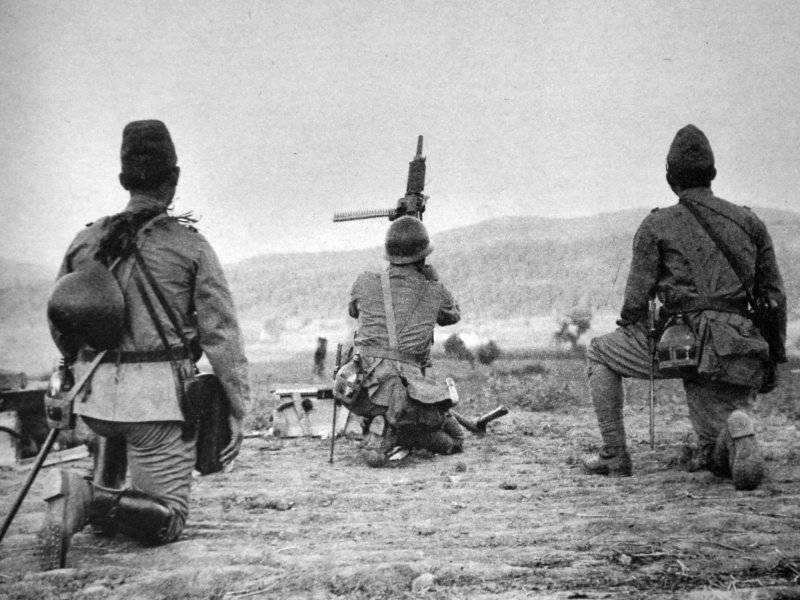
A Japanese soldier firing at air targets from an 7,7-mm machine gun Type 92 with ammunition from a rigid tape-cassette on 30 cartridges. The picture was taken during the fighting at Lake Hassan.
The positive features of the Type 92 included the possibility of firing both cartridges used in the army (Type 92 with low rim and Type 99 without edge), easy loading and unloading, large sizes of most important parts and survivability. For firing at air targets the machine gun had not a high rate of fire – 450 shots / min.
The 92 type was most often used with a special infantry tripod, which had an adapter for anti-aircraft fire. Included with the machine was attached annular anti-aircraft sight. The machine gun on the machine weighed about 55 kg, and for carrying it across the battlefield at the machine’s legs there were nests into which tubular handles were inserted — the machine gun was carried like a stretcher.
In 1937 he entered service tank Type 97 machine gun, created using elements of the Czech ZB-26, captured by the Japanese from the Chinese troops.

Tank machine gun Type 97
On a number of samples of Japanese armored vehicles were provided turret anti-aircraft options for placing this machine gun. However, in practice this happened infrequently, the Japanese industry was unable to saturate the troops with automatic weapons, and the machine guns were chronically lacking.
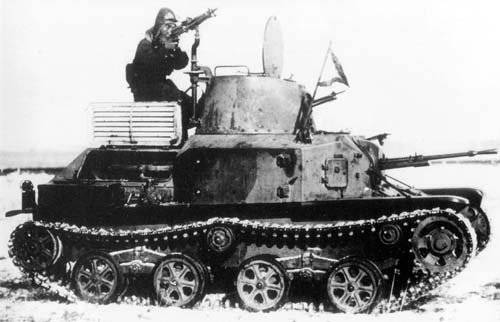
Machine guns of all types used up to eight different brands of non-interchangeable ammunition. Often, different rifle and machine-gun cartridges were used in the framework of not only one battalion, but companies and a platoon. In addition, Japanese troops widely replenished their stocks with captured machine guns (British “Lewis”, “Vickers” and “Bran”, as well as American M1917 and М1919 “Browning”). In total, they used various machine gun systems around 20 during World War II.
In general, anti-aircraft machine guns in the Japanese army was not enough, and the salvo shooting of infantry at the aircraft did not compensate for this.
In 1933, a large-caliber 13,2-mm machine gun Type 93 was adopted. This machine gun is a slightly reduced French machine gun “Hotchkiss” arr. 1930, the license for the production of which the Japanese government acquired from France.
13,2-mm armor piercing bullet Type 93 with an initial speed of 765 m / s punched 25-mm steel sheet at a distance of 100 m and was intended to destroy light armored vehicles and aircraft.
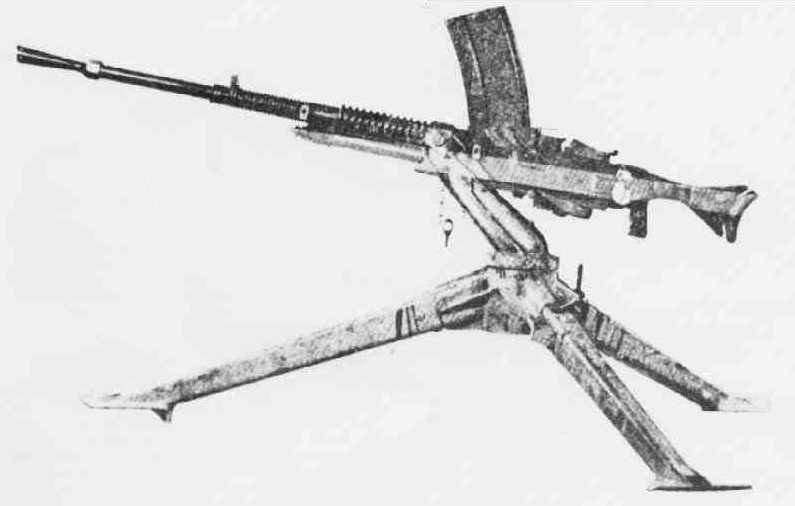
Large-caliber 13,2-mm machine gun Type 93
Initially, power was supplied from a hopper with a spring pusher, which led to the receiving window of the cartridge on 30 cartridges. A box store was later developed. The rate of fire of a machine gun Type 93 reached 480 shots / min, the effective range 1500 m.
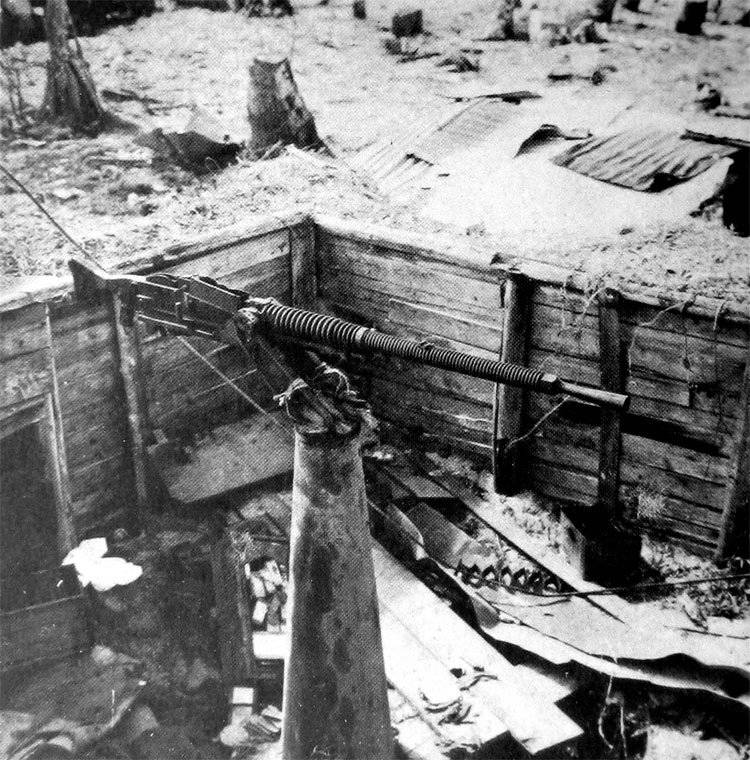
Machine gun weight 39,45 kg mounted on 57,15 kg tripod machine. But due to the fact that the infantry machine had an insufficient elevation angle, various semi-handmade turrets were often used to fire at planes.
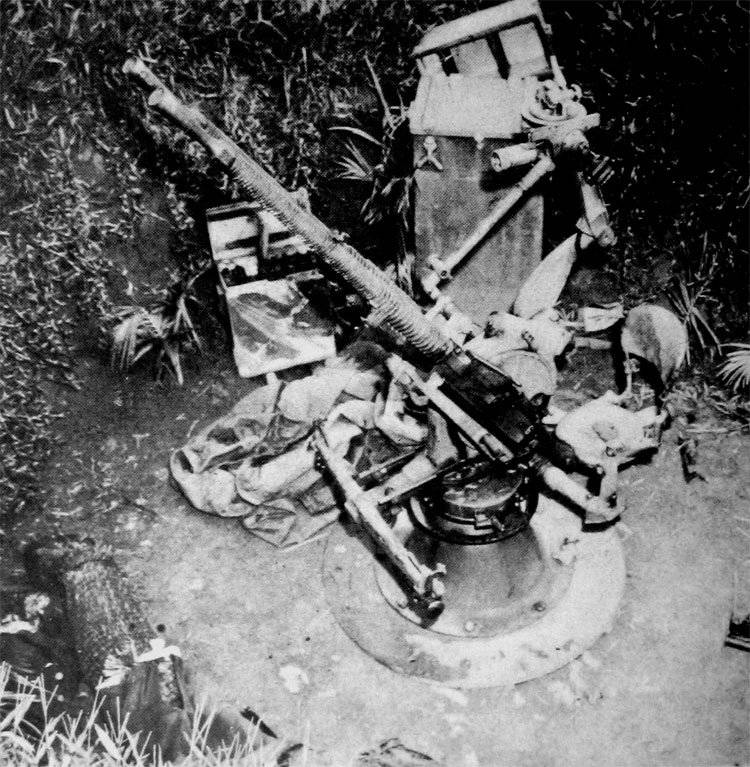
For anti-aircraft fire in small quantities, a paired version with vertical and horizontal guidance mechanisms of circular rotation with automatic anti-aircraft sights and a foot pedal for firing was released.

The American 12,7-mm M2 heavy-bore Browning machine guns, captured in significant quantities, were very popular in the Japanese armed forces. A copy of this machine gun, launched into production in the 1941 year, received the designation Type 1.
Due to the lack of a developed design school and traditions of independent creation of models of small arms and artillery weapons, to equip its own armed forces, Japan was forced to acquire licenses for production or illegally copy foreign models. This fully applies to small-caliber anti-aircraft machine guns.
The 1938-mm automatic cannon adopted in 20, the 98 type, in its construction, repeated the French machine gun “Hotchiss” mod. 1930 d. This weapon was originally developed as a dual-use system: to combat lightly armored ground and air targets.

20-mm automatic gun Type 98
The tall bed rested on two wooden wheels with knitting needles and was towed by a light truck or horse cart. The possibility of dismantling the gun for transportation by packs was also provided. On the position of the paws of the bed divorced, forming two rear supports, in addition to the third, front. After the final installation of the legs of the tripod (for the calculation of the 2-3 man, this process took 3 minutes), the gunner-gunner was located on a small seat. It was possible to shoot directly from the wheels, but in the process of shooting the gun became unstable and the accuracy deteriorated seriously.
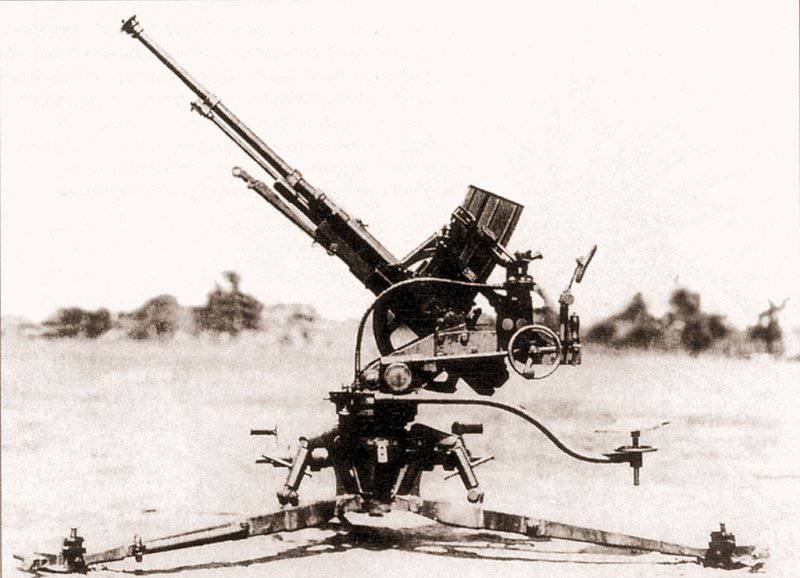
A gun with an angle of vertical guidance: –10 ° – + 85 ° could fire at targets in the 360 ° sector. The equipment of the 98 gun was quite powerful – the same as that of the Type 97 anti-tank gun. At a distance of 245 m he punched armor with a thickness of 30 mm. The initial velocity of the projectile – 830 m / s. Reach height – 3500 m.
Despite the relatively low rate of fire (120 shots per minute) and 20-ti shop, which limited the practical rate of fire, the gun was widely used in air defense. During the war years, troops received about 2500 20-mm Type 98.
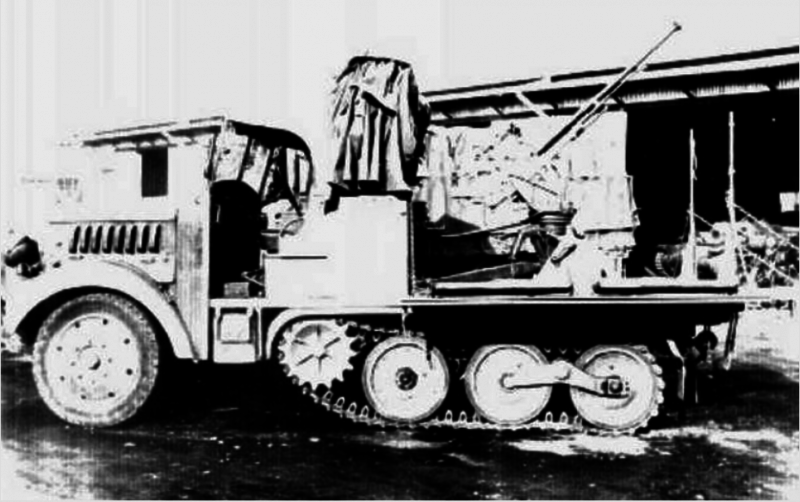
In Japan, attempts were made to create a ZSU by installing 20-mm Type 98 on light tanks and various semi-tracked transporters and trucks. Due to the insufficient number of self-propelled chassis and the chronic shortage of anti-aircraft guns in the army, Japanese ZSU were produced in very small quantities.
In 1944, the production of the twin version, designated as Type 4, began. Before the end of hostilities, the Japanese industry was able to deliver 500-mm X-pairs for 20.
As part of military-technical cooperation with Germany, samples and technical documentation were obtained for the Flak 20 38-mm anti-aircraft gun. In 1942, the 20-mm anti-aircraft gun under the Japanese name Type 2 began to enter the army. Compared to the 20-mm anti-aircraft gun, the 98 Type German copy proved to be more rapid, accurate and reliable. The rate of fire increased to 420-480 shots / min. Reach in height – 3700 m. Mass in the combat position: 450 kg, mass in the stowed position: 770 kg.
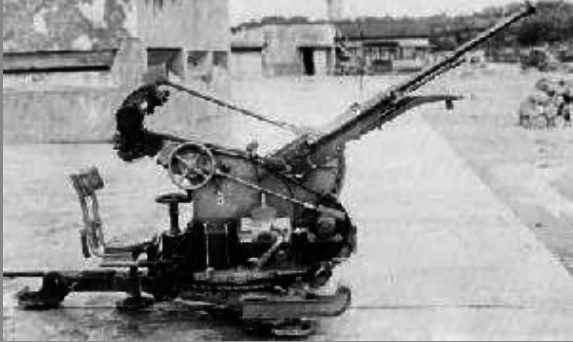
20-mm anti-aircraft machine 2 Type
Automatic building sights of these guns were developed vertical and lateral preemption and allowed to direct guns directly at the target. Input data in the sights were entered manually and determined by eye, except for the distance, which was measured by a stereo range finder. Together with the anti-aircraft gun, documentation was received on an anti-aircraft fire control device that could simultaneously transmit data and coordinate battery fire from six anti-aircraft guns, which significantly increased the effectiveness of firing.
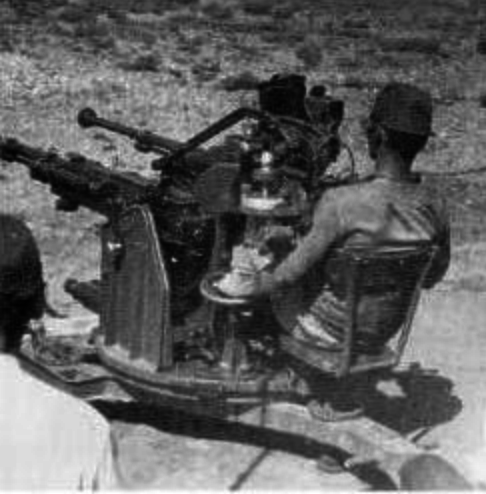
At the very end of the war, an attempt was made to launch the production of a paired version of this anti-aircraft gun. But due to the limited capacity of the Japanese industry to produce a significant number of such installations failed.
In the summer of 1937, the licensed production of Oerlikon 20-mm automatic guns began in Japan. Most of these automatic guns were designed to arm combat aircraft. But a number of guns used by the fleet as anti-aircraft. Attempts were also made to create a ZSU using Erlikon based on light tanks.
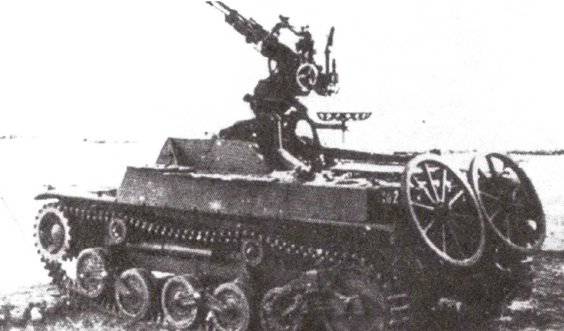
On the basis of a light tank Type 98 “Ke-ni” in 1942, were built in two versions experienced ZSU “Ta-ha”, armed with 20-mm automatic guns “Oerlikon”.
Perhaps the most well-known and massive Japanese small-caliber anti-aircraft gun was the 25-mm Type 96. This automatic anti-aircraft gun was developed in 1936 year on the basis of the gun of the French company “Hotchiss”. It was widely used during the Second World War, it was the main light anti-aircraft weapon of the Japanese fleet.
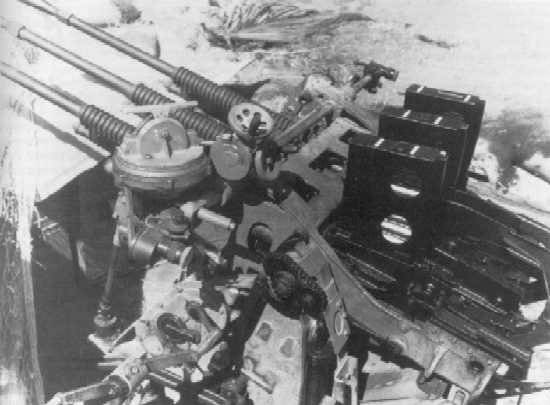
Built-in 25-mm anti-aircraft gun type 96
The 96 type was used in single, paired and structured installations, both on ships and on land. On large ships, the fire of built installations was controlled with PUAZO Type 95, guidance was carried out remotely, and the shooters only had to press the trigger. Single installations were induced only manually. Over the years, more than 33000 25-mm guns have been produced.
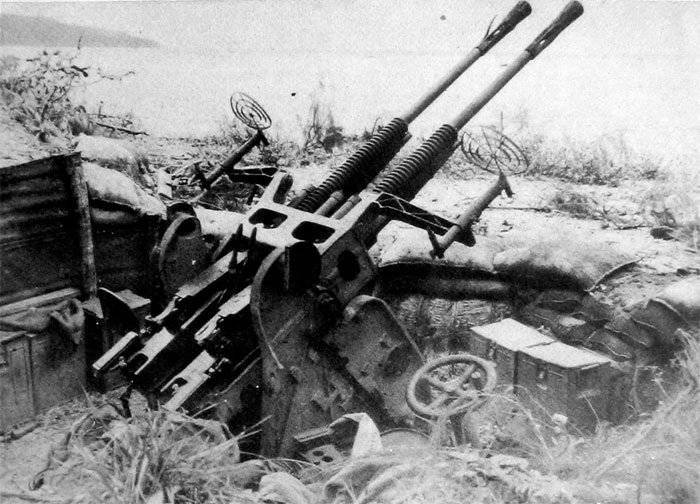
Twin 25-mm anti-aircraft gun type 96
The most significant difference of the Japanese model from the original was the equipment of the flame arrester of the German company “Rheinmetall”. The power supply of the machine was carried out with the help of magazines on 15 cartridges inserted from above. Practical rate of fire – 100 — 120 shots / min. Total weight: 800 kg (single), 1100 kg (paired), 1800 kg (built). The initial velocity of the projectile 320 g – 820 m / s. The maximum range of shooting – 7500 m, effective – 1500 m. Reachable height – 5000 m. Calculation 3-9 people.

25-mm anti-aircraft guns were also mounted on various vehicles and towed “carts”
Until the middle of the 1930-s, the 25-mm 96 Type anti-aircraft guns were quite satisfactory weapons. But during the war in the Pacific, significant shortcomings emerged. Practical rate of fire was low, optimal for weapons of this caliber would be tape power. Another drawback was the air cooling of gun barrels, reducing the duration of continuous firing. Anti-aircraft fire control systems also left much to be desired, and they were clearly not enough. Single anti-aircraft guns were equipped with a primitive anti-aircraft sight. However, it is fair to say that the Soviet 25-mm anti-aircraft machine 72-K had exactly the same drawbacks.
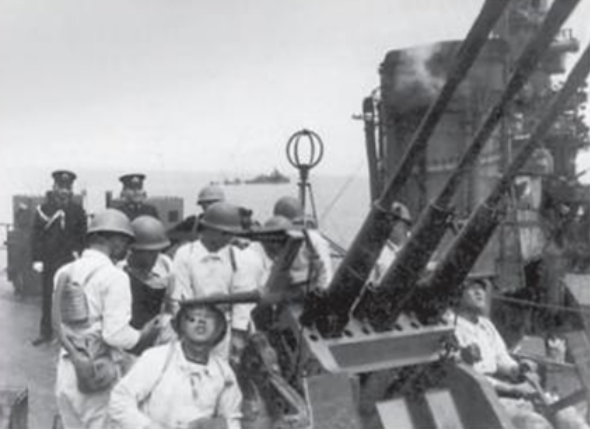
Triple-barreled 25-mm machine gun on the Oyodo cruiser
When comparing with anti-aircraft guns of the British, Dutch and American fleets, it should be noted that the opponents of Japan had more effective short-range anti-aircraft guns, represented by Oerlikon 20 and Bofors X-guns. The first surpassed the Japanese guns in the rate of fire, the second had a noticeably greater firing range and almost four times heavier projectile. The presence of highly sophisticated fire control systems for the Bofors fixed their superiority. The universal anti-aircraft 40-mm caliber of the Japanese fleet combined not the advantages of two calibers, but their disadvantages.
From 1927 to 1935, from the UK, around the 500 40-mm Vickers anti-aircraft guns Mark VIII were supplied from the UK for armament of large Japanese warships, also known as “pom pom.” In Japan, these anti-aircraft guns received the designation Type 91 or 40 mm / 62 “HI” Shiki.
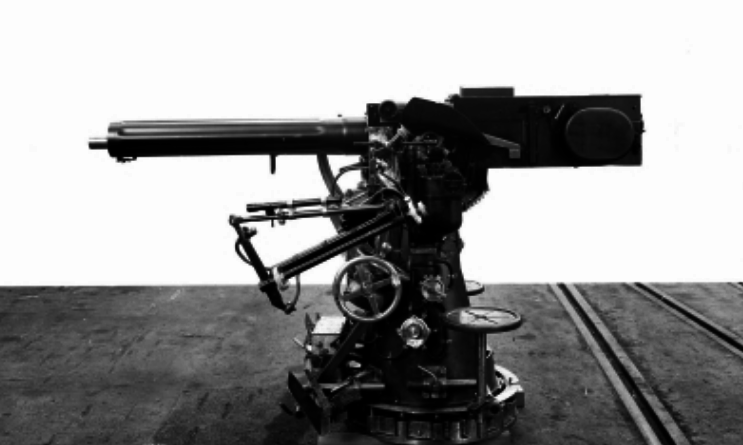
40-mm anti-aircraft machine 91 Type
The most famous ships armed with “pom pomom” in the Japanese fleet were “Ise” type battleships. By the end of the 30s, these anti-aircraft guns no longer met the increased requirements. The maximum range of guns was no more than 4500 meters, and the sighting is half as much. A serious problem was the archaic food. The complicated system of feeding the cartridge into the chamber, compounded by regularly jamming cloth cartridge tape. In a single anti-aircraft fire control system, “pom-poms” on Japanese ships were not tied up and each was guided individually.
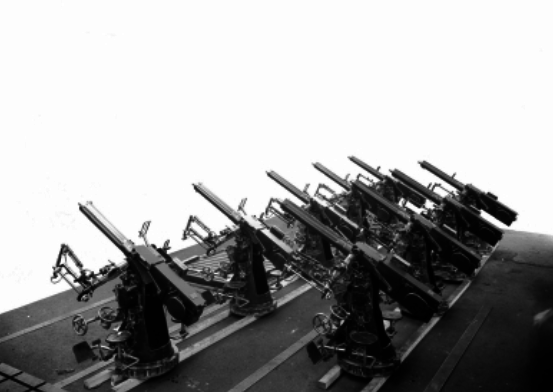
During ship repairs and upgrades, most 40-mm guns of the 91 Type were replaced with more efficient 25-mm anti-aircraft guns of the 96 Type. However, in the absence of a better 40-mm type 91 Japanese anti-aircraft guns were used throughout the war on auxiliary vessels and coastal batteries.
After the Japanese occupied a number of British and Dutch colonies in Asia, a significant amount of 40-mm Bofors L / 60 anti-aircraft guns and ammunition fell into their hands. During the fighting, the Japanese pilots had more than once the opportunity to see the combat effectiveness of these anti-aircraft guns. This time the Bofors were turned against their former owners.
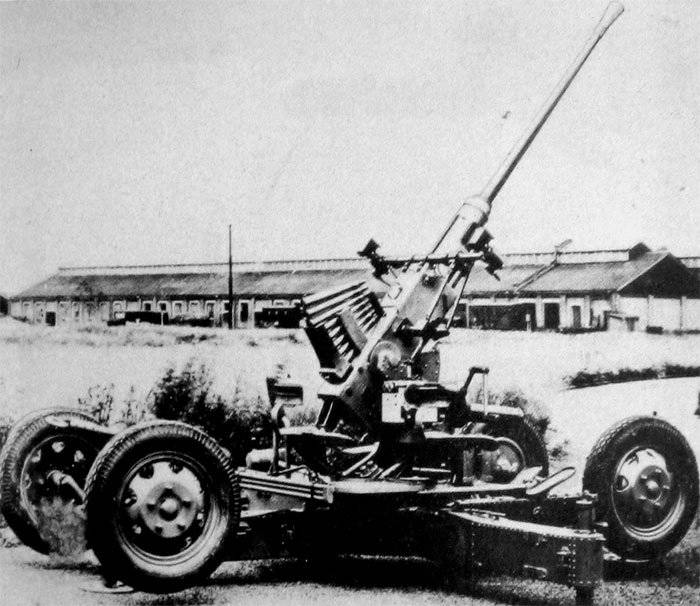
These captured anti-aircraft guns were very actively used by the Japanese army against British and American aircraft, especially since their anti-aircraft guns were constantly lacking. Moreover, the Bofors L / 60 naval anti-aircraft guns were dismantled from the ships captured and submerged in the shallow water.
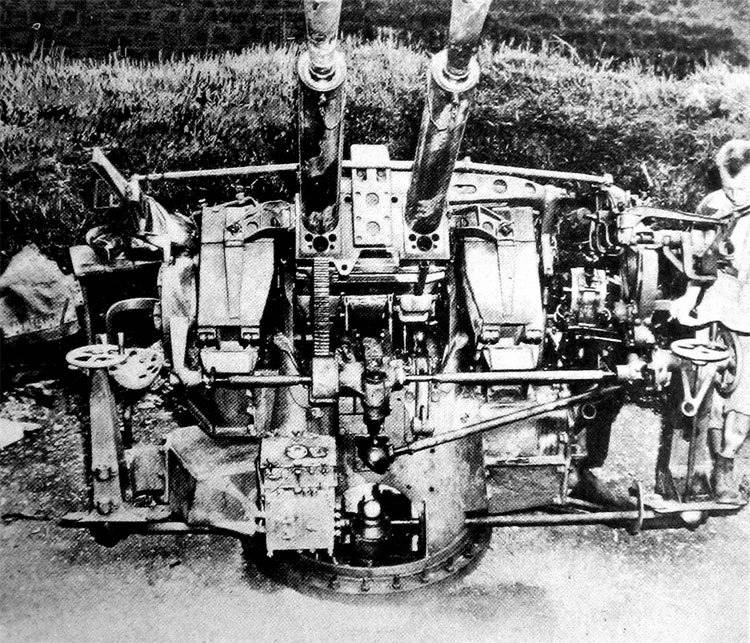
Former Dutch naval anti-aircraft installations Hazemeyer, which used twin 40-mm “Bofors”, were permanently installed on the shore and used by the Japanese to defend the islands.
In 1943, Japan attempted to copy and launch the Bofors L / 60 in mass production. The Japanese armed forces were in dire need of this anti-aircraft machine, which was very effective for its time.
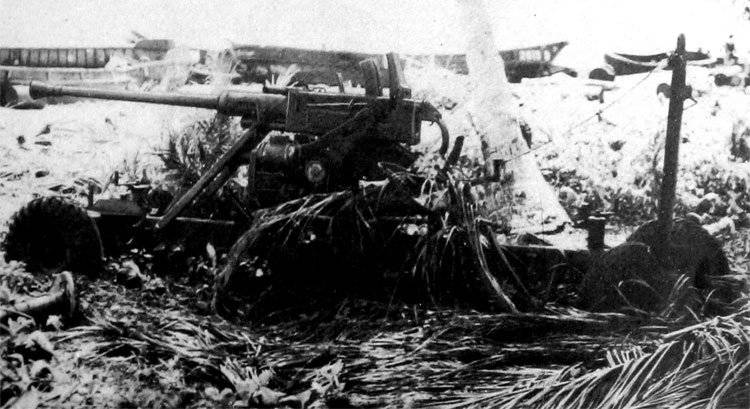
However, the development of production went with great difficulties. Japanese engineers lacked technical documentation, and the industry was unable to manufacture parts with the required tolerances.
The guns were actually assembled by hand at Yokosuka naval arsenal at the rate of release of 1944-5 guns per month at the end of 8. Despite the manual assembly and individual fitting of parts, the quality and reliability of Japanese 40-mm anti-aircraft guns received the designation Type 5 were very low. Due to their small size and unsatisfactory reliability, several dozens of these anti-aircraft guns did not affect the course of hostilities.
It should be recognized that the Japanese military industry was not able to start mass production with the required quality of small-caliber anti-aircraft guns to cover its troops from low-altitude strikes of attack aircraft and bombers. Such guns were primarily aimed at the needs of the fleet, the number of 25-mm anti-aircraft guns on the decks of warships during the war increased continuously, and units fighting on land remained unprotected from the threat from the air. This forced the Japanese military to go for various improvisations.
Perhaps the most original means of air defense of the Japanese ground units can be considered mortar shots caliber 70 and 81-mm. Each mine contained up to seven fragmentation submunitions that were ejected in the upper part of the trajectory at a distance of 900-1200 m and an altitude of about 600 m. Then the charges were scattered and lowered by parachutes. Each submunition was supplied with a contact and remote fuse.
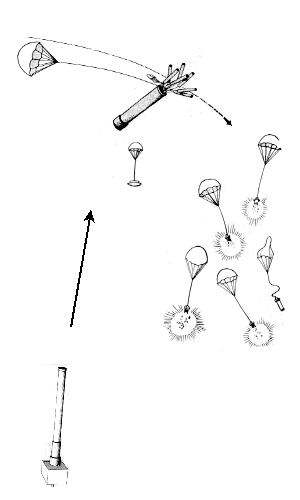
There are big doubts about the combat effectiveness of this means of combating aviation. It is likely that such cluster munitions could be effective against infantry.




